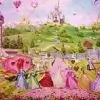There is a spiritual interpretation of the story of Rama which would be found beneficial to the entire mankind. According to the esoteric explanation of the Ramayana, man himself is the battlefield where a constant war is going on between the good and evil propensities. Information about the external world is collected through the five sense organs. These perceptions are turned into impressions with the help of mental background, different in different individuals. On the basis of these impressions the individual acts through the five organs of action. It is by controlling the sense organs and disciplining the mind with the help of the intellect that man can take proper action and lead a happy life. After continuous disciplining of the mind and the senses, ignorance is dispelled and one is able to discriminate between good and evil.
A person who is able to command his ten senses is called Dasaratha. Among his wives, Kausalya can be said to be an embodiment of Devotion, Kaikeyi of Attachment and Sumitra of Detachment. Similarly, Rama represents Wisdom, Bharata Discrimination, Lakshmana Renunciation and Shatrughna Thought. The knowledge contained in the Vedas is personified in sage Vashishtha who first teaches and trains the four princes'Rama, Bharata, Lakshmana and Shatrughna. It is only when wisdom, discrimination, renunciation and asceticism are combined that universal brotherhood or Vishwamitra emerges who imparts further training and help to Rama and Lakshmana to conquer evil forces like Tataka (Anger-lust combined), Maricha and Subahu (Temptation). After that sage Vishwamitra takes them to Mithila, the kingdom of Raja Janaka, to participate in Swayamvara, the, marriage function of his daughter Sita. On their way to Mithila, Rama revives Ahalya who had turned into stone i.e. without feeling and sensation, due to a curse which fell on her, and is again brought back to her full sensibilities.
There the contest was that whosoever lifts the bow of Siva, Sita will be married to him. Many princes and kings competed for the hand of Sita but they were not able even to move the great bow and were therefore disappointed. This bow, according to our allegory stands for pride and Sita is an embodiment of Devotion. Now unless a man is able to rise above pride, he cannot attain devotion.
Parasurama is a devotee of the Lord and stands for Ego. He was enraged not only as the great bow was lifted but broken into two. Whereas Rama tried to assuage the feelings of Parasurama with sweet words, Lakshmana, his brother almost challenged the great sage for unnecessarily interfering in the internal affairs of king Janaka.
As an embodiment of wisdom and being the eldest amongst the princes, Rama is rightly chosen by his father to be crowned as king, but on account of the intervention of Kaikeyi, he is compelled to banish Rama from the kingdom for 14 years. Thus Rama, Sita and Lakshmana left for the forest and minister Sumanta (i.e. Sukarma'good actions) accompanied them but wisdom (Rama) compelled him to go back to Ayodhya.
The trio (Wisdom'devotion'renunciation) proceeded further. The meeting of wisdom (Rama) with skillful Nishada helped the trio to cross the Tamsa river (river of Brahma-Vidya) on the boat of pure sankalpa and then accompanied with Nishad, the trio reached 'Triveni' the conjunction of three rivers (Ganga, Yamuna, Saraswati) which symbolically represent Ida, Pingla and Sushumana. On the bank of Triveni they had the darshan of Pranav (i.e. Bharadwaja) and afterwards of Valmiki Rishi (Discipline) who advised them (wisdom-devotion'renunciation) to stay at Chitrakut, the place of reasoning and understanding, for sometime.
When Bharata returned to Ayodhya from his maternal uncle's place, he is able to discriminate and see the injustice of the whole episode. But he fails to dissuade Rama from following the orders of his father as well as of Kaikeyi. Rama (Wisdom)does not leave the kingdom alone and is accompanied by Renunciation (Lakshmana) and Devotion (Sita). Then the trio left Chitrakut also. On the way they met the great sages Atri (Truth), and Anasuya, wife of Atri, an embodiment of loyalty and faithfulness.
The trio of Wisdom, Devotion and Renunciation occupy Panchavati'literally an abode standing for an embodiment of the five sense organs. There Surpanakha, the sister of Ravana and an embodiment of Desire, approaches Rama and Lakshmana for the satisfaction of her lust. But neither Wisdom nor Renunciation are attracted or lured by Desire who is not only turned away but also disfigured by Lakshmana. Surpanakha approached her brothers Khara and Dushana, who stand for Pride and Evil. But in a battle royal they are not able to measure swords with Wisdom and Renunciation. Whosoever makes use of wisdom before taking any action'and if that wisdom is tempered with renunciation'pride and evil cannot stand before the combination, and automatically disappears.
Then we reach the climax of the story where Ravana or Dasanana, literally a person with ten heads, decides to avenge the dishonour done to his sister. Having analysed that the ascetic princes are no ordinary individuals and have withstood not only Pride and Evil but also Desire, Dasanana decides to organise an attack with the help of Deceit, in the form of Maricha. Maricha or Deceit could assume a variety of forms and hence he was used by Ravana as a ploy to appear before Sita as a golden deer so that she might be attracted towards him.
It is said that at this juncture, in order to save Sita'a Princess who had been brought up in luxury'She was concealed by Rama with the help of Fire and in her place an illusion of Sita was created by him. It was this illusory Sita who fell for the golden deer and asked her husband to bring it for her. Rama, through his wisdom saw the game but on account of Sita's persistence and to play his part in the cosmic drama gave the deer a chase.
The deer enticed him away from Panchavati and as he was dying, he cried Lakshmana as if it was Rama himself crying for his help. The illusory Sita heard the cry and asked Lakshmana to rush to Rama's help. Lakshmana tried to assure Sita that no calamity could befall the wise and brave Rama but she insisted and even insinuated motives to Lakshmana who had to leave to find out facts. When Sita was alone, Ravana approached Panchavati as a hermit, begging for alms and took her away forcibly. He was intercepted by Jatayu, an embodiment of peace, who lives for others, but who was fatally wounded.
Since Rama is depicted in the Ramayana as an ordinary but an ideal man, finding Sita missing, he begins to lament and cry for help as any husband would do. Finally he runs into Jatayu who tells him the truth. Several efforts are made to dissuade Ravana from evil path and to make him return Sita, but nothing avails of. Finally, Rama strikes friendship with Sugreeva, who is personified action, which has lost power and strength on account of the defeat inflicted upon him by his brother Bali, literally a very brave man. Sugreeva introduces Rama to Hanuman who stands for absolute renunciation, who is sent to find out the exact whereabouts of Sita.
On the way, the water-spirits' Surasa, Simhika and Lankini' standing for three attributes of Sattva, Rajas and Tamas, which pervade the universe'try to hinder the progress of Hanuman. He rises above all the three attributes and it is only after he masters all of them that he reaches Lanka and finds out Sita in the forest of Ashoka trees. After delivering the message of Rama to her, he creates havoc in the city and lets himself be caught by Meghanatha so that he is produced in the court of Ravana.
There he speaks of the valour and virtues of Rama and tries to dissuade Ravana from evil ways. Ravana's brother Vibhishana also tries to give good advice to the king and asks him to return Sita so that bloodshed may be avoided. But the king strikes at Vibhishana and turns him out of the court, who then joins the forces of Rama. Even the entreaties of Mandodari, his queen, do not prevail upon the king. Wisdom (Rama) also sends another emissary, Angada, to persuade Ravana to give up his evil ways. But Attachment and Desire, as personified in Ravana are determined to have their way and finally a battle royal ensues.
Ravana had all the evil forces like Greed, Deceit and others on his side but they were all destroyed by Rama, causing consternation in Ravana. But his Desire in the form of his son Meghanatha, consoled him and succeeded in striking at Renunciation (Lakshmana) sending him to sleep for a short while, but Good Actions in the form of the medicine-man Sukhena came to the help of Renunciation and revived him with the help of the Sanjivini herb, i.e. determined good action. Even Kumbhakarana standing for pride, could not stand before wisdom and was killed. Finally Desire and Attachment (Ravana) were completely annihilated by Wisdom and when illusory Sita came to Rama, Wisdom declared that he had no place for Maya and sent her back to fire.
Bharata had been ruling Ayodhya with great discrimination and once the period of 14 years was over, Wisdom, Renunciation along with Devotion, Absolute Renunciation, Bravery and other attributes returned to Ayodhya, to establish the reign of righteousness'Ramaraj.






























